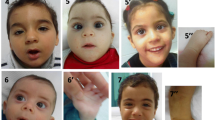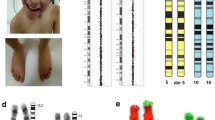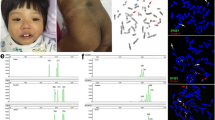Abstract
Recent molecular cytogenetic studies have elucidated the origin and nature of extra structurally abnormal chromosomes (ESACs) or small supernumerary chromosomes, which are often associated with developmental delay and malformations. We studied the prevalence of inv dup(15) in a nationwide screening programme for mentally retarded children in Taiwan and tried to correlate the genotype and phenotype in those patients. Fluorescence in situ hybridization (FISH) analysis using D15Z, D15Z1, and the cosmids from the Prader-Willi/Angelman syndrome chromosome region (PW/ASCR) was performed on 54 patients (0.45%) with ESACs from 11893 probands within a 5-year period. Of them, inv dup(15) was confirmed in 25 children (46.3%) by FISH analysis. The PW/ASCR probes were used to clarify the size and DNA composition of the markers. Patients with inv dup(15) chromosomes, containing only the heterochromatin or little euchromatin of the proximal 15q (i.e., pter→q11:q11→pter) may have a rather mild or nearly normal phenotype (group 1). Only one patient had some features suggestive of Angelman syndrome, but was considered to be a result of deleted (15)(q12) in the chromosome 15 homologue. Additional copies within D15S11 through GABRB3 (15q11.2-13) resulted in an abnormal phenotype which involved mental and developmental delay but was different from the classical phenotype of PW/AS (groups 2, 3). Signs of autistic behavior did occur in each group. FISH combined with microsatellite analyses showed that the marker was often of maternal origin in de novo cases (n = 12, 86%), or inherited from the mother in only one familial case. Down-inv dup(15) was mentioned in two cases. Unusual features including diaphragmatic eventration, hyperlaxity of joints, arachnodactyly, brain atrophy, epilepsy (particularly infantile spasm), ataxia, genital abnormalities, and cleft lip/palate were noted in those patients. This observation expands the range of phenotypic expression associated with this relatively common ESAC.
Conclusion Marked phenotypic diversities exist in children with inv dup(15), dependent upon the size or genetic composition of the markers, degree of mosaicism, parental origin and familial occurrence or not. Patients with a larger inv dup(15) marker chromosome including the PW/ASCR may have a higher risk of abnormalities, but not the typical Prade-Willi/Angelman syndrome phenotype.
Similar content being viewed by others
Author information
Authors and Affiliations
Additional information
Received: 11 February 1997 and in revised form: 20 May 1997 / Accepted: 20 May 1997
Rights and permissions
About this article
Cite this article
Hou, JW., Wang, TR. Unusual features in children with inv dup(15) supernumerary marker: a study of genotype-phenotype correlation in Taiwan. Eur J Pediatr 157, 122–127 (1998). https://doi.org/10.1007/s004310050782
Issue Date:
DOI: https://doi.org/10.1007/s004310050782




